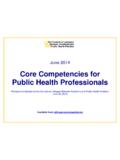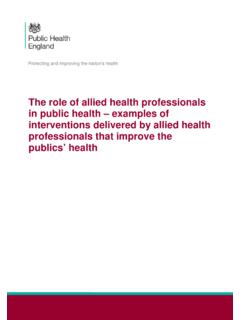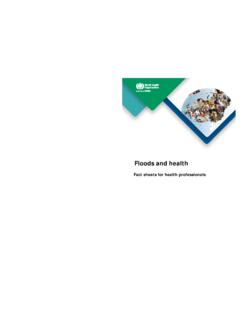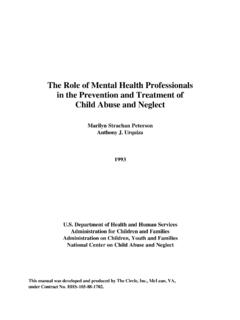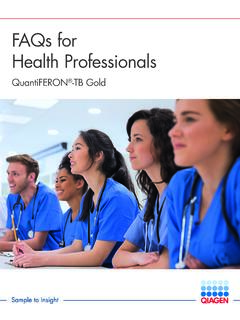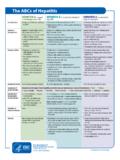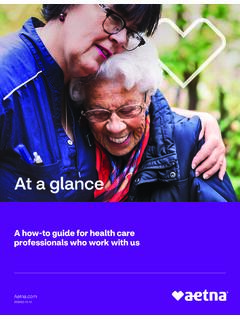Transcription of A Guide for Health Professionals T
1 ItaliansA Guide for Health Professionalshis profile provides anovervie w of some ofthe cultural and Health issuesof concern to Italian migrantswho live in Queensland,Australia. This description maynot apply to all Italians asindividual experiences mayvary. The profile can, however,be used as a pointer to someof the issues that may concernyour are the largest group of overseasborn in Australia, after migrants fromUK and to Australia dates from the 19thcentury. In Queensland, a small settlement ofItalians was formed in the Wide Bay districtin 1890, and the following year theQueensland government brought out over 300agricultural labourers to work as cane were joined by other Italians through a chain migration, in which people from aparticular village, town or district in Italyfollowed one another to the Second World War, many Italiansin northern Queensland were interned or wereplaced under severe restrictions.
2 After thewar, Australia provided fare assistance forworkers willing to work in selected jobs,usually in the cane fields. In Queenslandthere are approximately 17,000 official language in Italy is Italian, butthe first language spoken is often a localdialect. Elderly and uneducated migrants maybe unable to speak the standard languagecorrectly. Not all people have had theopportunity to learn English, and in the 1996census, approximately 18% of Italian-bornmales and females in Queensland could notspeak English well or at all. Patient Interactionstalians tend to be highly expressive ofjoy, sadness and grief, both vocally andby overt body gesture. A high level ofphysical contact is considered both naturaland are plentiful in Italy, and the doctor ssocial and financial status is not as high as itis in Australia.
3 The Italian client will expectto be listened to as an equal when discussingsymptoms and treatment. Health in AustraliaLifestyleLifestyle risk factors are often present inItalians as a result of low exercise problems include overweight(women more than men) and smoking (men).Alcohol is used less by Italians than thegeneral population. Both men and womenhave lower mortality rates than the generalAustralian population. Health statisticsoThere were lower mean systolic anddiastolic blood pressures in Italian bornIntroductionIIIIITALYCORSICASARDINIA SICILYM editerraneanSeaTyrrhenian SeaAdriatic SeaTUNISIASLOVENIACROATIABOSNIA &HERZERGOVIA migrants compared with an age-matchedAustralian-born and obesity are higher in malesborn in Southern Europe, but there is alow level of mortality due to heart andrespiratory rates are higher in Italiansthan the general Australian rates from diabetes are higherin Italian than in other of the stomach and cancer of thenasopharynx are more frequent than inthe general Australian myeloma was found at a higherprevalence in Italian migrants in aWestern Australian migrants worked in asbestosmines such as Wittenoom.
4 WesternAustralia in the 1940s to late have a high risk of mesothelioma. Utilisation of Health Services eing in hospital may be traumaticbecause of the separation fromfamily and friends, particularly for an olderItalian person with difficultiescommunicating in English, or limitedmedical knowledge. Hospital admission maybe seen as justified only for operations, ordramatic treatments or investigations. Alliedhealth services are often unfamiliar to olderItalians, so their purpose needs to beclearly Beliefs and Practicesn the past, tonic injections weresometimes given intramuscularly bylay people in Italy. Intramuscular medicineis still seen as superior to oral medicationin many cases. Traditional Italian healthconcepts derived from humoral , except for the older Italian peoplewho came as unskilled labourers under themass mig ra t ion sche me, community attitude sand knowledge about Health issues are notgreatly different from the mainstream.
5 Mental Healthhose with mental illness may bestigmatised. Because initially theymay be ashamed of their disabled child, andmay not use the services available, parentsof children with disabilitie s, such as cere b ra lpalsy or mental retardation, may take timeto come to terms with the violence occurs in the Italian asin all communities, but it may be hidden fora long period in order to maintain thefamily Care of the Agedhe Italian community has an ageingpopulation. The peak period ofmigration was in the 1950s. Thecommunity infrequently receives young newarrivals, although some still come under the skilled worker scheme. By the year 2001,there are likely to be 121,000 Italians aged60 and over in do not always use the services forthe elderly, and there are low nursing homeadmission rates.
6 Italians often expect to becared for by their children in their old care for the elderly usually falls on thewomen of the Italians may not speak English, orfind it harder to remember the newlanguage as they get older. They may bege2 BBTTTTII frustrated and isolated by the youngergeneration s inability to speak Italian. Family members who act as interpreters maynot pass on all the information to theelderly, especially if bad news is addition, older Italians are unlikely to beable to access information themselves, evenif presented in Italian, as they may havehad little education or have poor eyesightfor Healthhildren from Italian speakingfamilies have higher rates ofimmunisation than other Australiansaccording to one used to be closely chaperoned oncethey reached puberty.
7 However, in recentdecades, young people have become moreindependent, moving away from the familyhome before s Healthwareness of women s healthissues among older Italianmigrant women is poor, with low rates ofwomen having a Pap test, breastexamination or a mammogram, or evenhaving heard of these screening may only seek services for seriousillness, not for screening. Younger womenhave more knowledge of these issues anduse mainstream Health is lower use of the contraceptive pillin Italian women than Australian the average family size is womenThere is social/peer pressure from outsidethe Italian community for young women tobe slim. However, there is pressure withinItalian families to eat as part of socialoccasions, and not eating can be seen asrejection of the Italian culture.
8 The youngItalian woman gains no support for dieting,as a bit of extra weight is seen as a sign ofgood Health . Meals and weight can becomea cause of tension in the womenMenopause may be perceived as a timewhen body functioning slows, causingvulnerability to a range of diseasesincluding cancer. Often minor ailments areattributed to the effects of the Ethnic Affairs Directory of the Premier and of Ethnic and Multicultural - Italian-Australian WelfareAssociationTel: (07) 3832 2125 COMITES (Committee for Italians Abroad)Tel: (07) 3856 0244 The Italian-Australian Welfare Association(Granite Belt) IncTel: (076) 815 283 Brisbane Migrant Resource CentreTel: (07) 3844 8144 Ethnic Community Council of QueenslandTel: (07) 3844 9166 Logan City Multicultural Neighbourhood CentreTel: (07) 3808 4463 Ethnic Communities Council Gold Coast Tel: (07) 5532 4300 Multicultural Information Network ServiceInc.
9 (Gympie) Tel: (07) 5483 9511P3 CCAAM igrant Resource Centre Townsville-Thuringowa : (077) 724 800 Translating and Interpreting ServiceTel: 131 450 Acknowledgmentshis profile was developed by PascaleAllotey, Lenore Manderson, JaneNikles, Daniel Reidpath and Jo Sauvarin atthe Australian Centre for International andTropical Health at The University ofQueensland, on behalf of QueenslandHealth. It was developed with theassistance of community groups, includingCoAsIt, COMITES and The Italian-AustralianWelfare Association (Granite Belt) Inc, andhealth care is a condensed form of the full profilewhich may be found on the QueenslandHealth INTRANET - QHiN and theQueensland Health INTERNET hssb/ Thefull profile contains more detail and someadditional information. It also containsreferences to additional source for this profile was drawn from anumber of sources including variousscholarly publications.
10 In addition, Culture& Health Care (1996), a manual prepared bythe Multicultural Access Unit of the HealthDepartment of Western Australia, wasparticularly












